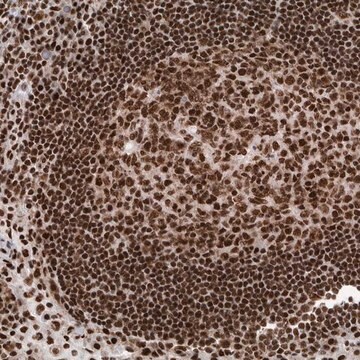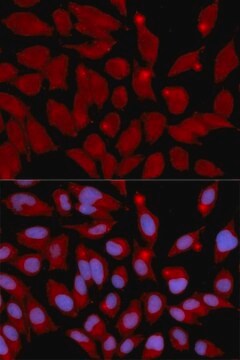SRP0396
DNMT3A/DNMT3L active human
recombinant, expressed in baculovirus infected Sf9 cells, ≥90% (SDS-PAGE)
Zaloguj sięWyświetlanie cen organizacyjnych i kontraktowych
About This Item
Kod UNSPSC:
12352200
NACRES:
NA.32
Polecane produkty
pochodzenie biologiczne
human
rekombinowane
expressed in baculovirus infected Sf9 cells
Próba
≥90% (SDS-PAGE)
Postać
aqueous solution
masa cząsteczkowa
34 kDa (MLL1)
52 kDa (DNMT3L)
opakowanie
pkg of 10 μg
numer dostępu NCBI
numer dostępu UniProt
Warunki transportu
dry ice
temp. przechowywania
−70°C
informacje o genach
human ... DNMT3A(1788) , DNMT3L(29947)
Opis ogólny
The DNMT3A (DNA (cytosine-5)-methyltransferase 3A) gene is mapped to human chromosome 2p23. The encoded protein has 2 isoforms, DNMT3A1 and DNMT3A2. DNMT3A1 is widely expressed and DNMT3A2 is mainly present in embryonic stem cells (ovaries and testes).
DNMT3L (DNA (cytosine-5)-methyltransferase 3-like) belongs to the Dnmt3 family. It is unable to methylate DNA. The protein has a cysteine-rich region containing a novel-type zinc finger domain. The gene is mapped to human chromosome 21q22.3.
DNMT3L (DNA (cytosine-5)-methyltransferase 3-like) belongs to the Dnmt3 family. It is unable to methylate DNA. The protein has a cysteine-rich region containing a novel-type zinc finger domain. The gene is mapped to human chromosome 21q22.3.
Zastosowanie
DNMT3A/DNMT3L active human has been used in in vitro methylation assay and REMSA (RNA electrophoretic mobility shift assay) to study role of ecRNAs (extra coding RNAs) in DNA methylation.
Działania biochem./fizjol.
DNMT3A (DNA (cytosine-5)-methyltransferase 3A) is a DNA methyltransferase. It is responsible for the methylation of the cytosine residue in 5′-C-phosphate-G-3′ (CpG) dinucleotides. DNMT3A plays a significant role in immunoregulation (adaptive as well as innate immune responses). It is also the most commonly mutated gene in hematologic malignancies. DNMT3A is a commonly mutated gene in acute myeloid leukemia and is responsible for an unfavorable prognosis.
DNMT3L (DNA (cytosine-5)-methyltransferase 3-like) is mainly responsible for the stimulation of DNA methylation. It is a non-catalytic accessory factor. It helps the DNA methylation machinery to be placed on properly chromatinized DNA regions. It also helps the poorly methylated area, thereby providing uniform methylation patterns. Mutations in the DNMT3L gene might be associated with azoospermia susceptibility.
DNMT3L (DNA (cytosine-5)-methyltransferase 3-like) is mainly responsible for the stimulation of DNA methylation. It is a non-catalytic accessory factor. It helps the DNA methylation machinery to be placed on properly chromatinized DNA regions. It also helps the poorly methylated area, thereby providing uniform methylation patterns. Mutations in the DNMT3L gene might be associated with azoospermia susceptibility.
This page may contain text that has been machine translated.
Kod klasy składowania
10 - Combustible liquids
Klasa zagrożenia wodnego (WGK)
WGK 1
Temperatura zapłonu (°F)
Not applicable
Temperatura zapłonu (°C)
Not applicable
Certyfikaty analizy (CoA)
Poszukaj Certyfikaty analizy (CoA), wpisując numer partii/serii produktów. Numery serii i partii można znaleźć na etykiecie produktu po słowach „seria” lub „partia”.
Masz już ten produkt?
Dokumenty związane z niedawno zakupionymi produktami zostały zamieszczone w Bibliotece dokumentów.
DNMT3A Haploinsufficiency Transforms FLT3ITD Myeloproliferative Disease into a Rapid, Spontaneous, and Fully Penetrant Acute Myeloid Leukemia.
Meyer SE
Cancer Discovery, 6, 501-501 (2016)
DNMT3A Loss Drives Enhancer Hypomethylation in FLT3-ITD-Associated Leukemias.
Yang L, et al.
Cancer Cell, 29, 922-922 (2016)
The CpG island encompassing the promoter and first exon of human DNMT3L gene is a PcG/TrX response element (PRE).
Basu A, et al.
PLoS ONE, 9, e93561-e93561 (2014)
Association between single-nucleotide polymorphisms of DNMT3L and infertility with azoospermia in Chinese men.
Huang JX, et al.
Reproductive Biomedicine Online, 24, 66-66 (2012)
Isolation and initial characterization of a novel zinc finger gene, DNMT3L, on 21q22.3, related to the cytosine-5-methyltransferase 3 gene family.
Aapola U, et al.
Genomics, 65, 293-293 (2000)
Nasz zespół naukowców ma doświadczenie we wszystkich obszarach badań, w tym w naukach przyrodniczych, materiałoznawstwie, syntezie chemicznej, chromatografii, analityce i wielu innych dziedzinach.
Skontaktuj się z zespołem ds. pomocy technicznej








